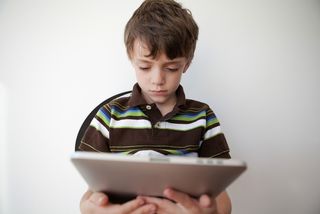iPads in the Classroom, But Do They Help Kindergartners?

When it comes to technology in the classroom, having kindergartners share iPads may be better for learning than simply giving each child an iPad, a new study suggests.
The study involved 350 students from three schools in a Midwestern school district where iPads were being phased into classrooms. This created a natural experiment in which one school had an iPad for every student, a second school had 23 iPads for students to share, usually in pairs, and a third school that had no iPads.
In all classrooms with iPads, students used similar apps, including apps for math and literacy, and played similar games with the devices.
On an end-of-year achievement test, which mostly measures early literacy skills, students who shared iPads scored about 30 points higher than both students in classrooms with an iPad for every child and students in classrooms without iPads. (Scores on the test can range from 300 to 900 points.) [7 Ways to Short-Circuit Kids' Mobile Addiction]
Besides the iPads, there were no major differences between the classrooms in terms of their demographics, earlier test scores or teacher-student interaction. This suggests that sharing iPads may have been the reason for the improved test scores, the researchers said.
"I went in thinking one-to-one would have been better than shared iPads," said study researcher Courtney Blackwell, a doctoral student at Northwestern University's Center on Media and Human Development.
As for why sharing iPads might improve learning, the researchers suspect it has to do with the boost in social interaction, which is important for development in young children.
Sign up for the Live Science daily newsletter now
Get the world’s most fascinating discoveries delivered straight to your inbox.
"I think when they had to share the iPads it was encouraging those social interactions. There was more talk about what they were doing on the iPads," said Blackwell, who also observed the children in the classrooms.
Still, because the students in the classrooms with no iPads scored lower than the children in classrooms with shared iPads, it seems that it's not just the social interaction by itself, but the social interaction together with the technology, that's driving the results, Blackwell said. (The researchers presume that there were other social interactions going on, without technology, in the classrooms that did not have iPads.)
What's more, the improvement in test scores seen in the study is on par with improvement seen after other education interventions, such as homework, Blackwell said.
Because the study was conducted in just three schools in the U.S. Midwest, more research is needed to verify the results. But the findings may be something to consider in light of the recent push in some schools to bring in iPads for every child. (The Los Angeles Unified School District had planned to spend $1.3 billion on iPads for every student, although the initiative has stalled.)
Schools should consider that "one-to-one might not be the best for every grade level and every child," Blackwell said.
Schools that already have iPads for every child may want to revise how the devices are used in the classroom to include more group activities, the researchers said.
In addition, "schools may reconsider their tablet implementations for younger children, given the large financial investment needed to provide 1:1 iPads and the lack of evidence to support the need for individual iPads in kindergarten," the researchers said.
The study will be presented at the upcoming 65th Annual Conference of the International Communication Association in San Juan, Puerto Rico.
Follow Rachael Rettner @RachaelRettner. Follow Live Science @livescience, Facebook & Google+. Original article on Live Science.

Rachael is a Live Science contributor, and was a former channel editor and senior writer for Live Science between 2010 and 2022. She has a master's degree in journalism from New York University's Science, Health and Environmental Reporting Program. She also holds a B.S. in molecular biology and an M.S. in biology from the University of California, San Diego. Her work has appeared in Scienceline, The Washington Post and Scientific American.
Most Popular


